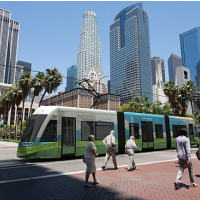City Knew L.A. Streetcar Costs Were Way off before Voters Approved Them
 Proposed downtown L.A. streetcar (Drawing: Los Angeles Streetcar Inc.)
Proposed downtown L.A. streetcar (Drawing: Los Angeles Streetcar Inc.)
When Los Angeles city voters went to the polls in November, they encountered a ballot measure to fund construction of a downtown streetcar. The website “We Want Streetcar” described the moment thusly: “The modern revitalization of Los Angeles’ once renowned Streetcar system has confronted and successfully overcome a foray of obstacles in the last decade and has, at long last, come up against a final hurdle. Now the Streetcar needs one more thing . . . your vote.”
Turns out, there was one more thing the Streetcar needed besides a vote—twice as much money as the ballot measure indicated. And judging by a Los Angeles Times review of documents and e-mails, city staffers knew the price tag was too low.
Voters overwhelmingly approved the measure to raise $63 million through a property tax assessment on those within a newly-designated special district encompassing the 4-mile route. The city and matching federal funds would cover the rest of the $125 million project.
Last month, the Los Angeles Times reported that the trolley will actually cost at least $327.8 million. Early construction estimates failed to take into account inflation and the cost of dealing with the cable, pipes and other utility clutter that runs under the streets.
What kind of engineering study of a multi-million-dollar project doesn’t factor in those basic elements?
On Monday, Jessica Wethington McLean, an aide to City Councilman José Huizar (in whose district the project resides), told the Times the original estimate was figured out on the “back of an envelope.” That’s a restrained way of saying it was made up.
Eric Metz, the nonprofit's project director, elaborated. “It's really that simple. We didn't hire an engineer or anything that fancy.”
As any shopper knows, things are a lot cheaper when you don’t get fancy, but that approach tends to work better when purchasing things that don’t weigh tons and move along city streets.
City officials had an inkling that the $125 million price tag was a tad low by the time the election rolled around, but it wasn’t publicized. The original plan had an early, rough estimate from HDR Inc., a large engineering consultant, and was going to be executed through the city’s Community Redevelopment Agency (CRA). But the Brown administration, looking for scarce dollars during a budget crisis, pushed through legislation that dissolved the CRAs.
The project was taken over by the city’s Transportation Department, where questions were raised about the missing cost components, according to the Times. “Do not know what is under the street. Could add significantly to cost overruns,” James Lefton, the department's executive officer of transit services, noted in July 2012.
The streetcar issue is careening toward a January deadline for the next cost estimate, and speculation is that if it officially gets above $250 million, federal funding could evaporate and the project could be delayed or killed.
For now, estimates based on “back-of-the-envelope” calculations that the streetcar could be rolling by 2016 are being revised. Presumably, those revisions will be made public in a timely fashion.
–Ken Broder
To Learn More:
City Hall Staff Kept Quiet on L.A. Streetcar Red Flags (by Laura J. Nelson, Los Angeles Times)
Utility Relocation Costs Not a Death Sentence for Downtown LA Circulator (by Juan Matute, LA.StreestBlog)
Broadway Streetcar Faces $200-Million Funding Gap (by Laura J. Nelson, Los Angeles Times)
Voters Approve $85 Million Downtown Streetcar Tax (by Richard Guzman, Downtown News)
- Top Stories
- Controversies
- Where is the Money Going?
- California and the Nation
- Appointments and Resignations
- Unusual News
- Latest News
- California Forbids U.S. Immigration Agents from Pretending to be Police
- California Lawmakers Urged to Strip “Self-Dealing” Tax Board of Its Duties
- Big Oil’s Grip on California
- Santa Cruz Police See Homeland Security Betrayal in Use of Gang Roundup as Cover for Immigration Raid
- Oil Companies Face Deadline to Stop Polluting California Groundwater





